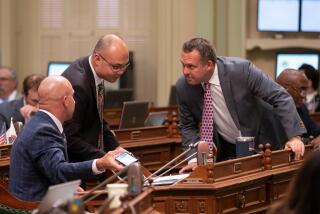A Farmer Argues His Right to Sell Land at a High Price
SALIDA, Calif. â It was the nuisance factor that finally did him in--the sheer grind of farming a piece of land within bicycling, theft and vandalism range of the Stanislaus County citizenry.
âPeople seem to think that itâs a nice, big orchard out there, and the owner wonât mind if I go pick a bag of peaches,â says Ron Vella, a third-generation farmer who recently sold an orchard in this rapidly developing farm town. âI might want to walk into their front room and take a vase off the goddamn table. Itâs no different.â
For Vella and many of his fellow farmers, agricultural preservation comes down to two things: Property rights and their violation. The violation starts as soon as development begins, he says, and it doesnât stop until farmers are forced to farm in untenable conditions.
Agricultural preservation plans that would rope off prime land for farming in perpetuity ignores the fact that farms are businesses, to be run when theyâre healthy and folded when they cease to make money. And the greatest threat to a viable farm is a clash with new neighbors.
âThe big problem with agriculture next to urban transition areas is you have people who think they can ride their bicycles and Hondas anywhere they want,â Vella said. âThey clean out their yards, and we catch them sweeping out their pickups in the middle of our orchards.â
Then thereâs the vandalism, he says. You go out one morning and find your diesel tank full of dirt or your tractor tires slashed. Vella has had radiators shot and gauges blown up, water poured into loose engines.
He paid the price of development, and now development has paid him back. Last summer, Vella sold 78 acres of prime Salida farmland to developers who plan to build a 700-acre subdivision. Groundbreaking should be later this year.
Brian Velthoen was the land broker who put the package together. He is currently working on a 1,600-acre parcel a bit farther north, contacting farmers about selling out for prices in the $75,000- to $100,000-per-acre range.
âFour years ago, they wouldnât have even considered selling,â Velthoen said.
In 1985, he said, his brokerage firm had listings in the $25 million to $30 million range, of which 30% was raw land, acreage that farmers wanted to take out of agriculture. Five years and thousands of new residents later, Velthoenâs Central Valley business is up to $80 million in listings, of which 80% is raw land.
Although Vella opposes rampant growth and continues to farm about 260 acres in the Modesto area, he vehemently opposes agricultural preservation efforts in the Stanislaus County General Plan. Those efforts, he says, would make âslavesâ out of farmers by stripping them of options and chaining them to land that they cannot afford to farm.
âI donât know what the answer is,â he says. âHow do you tell Farmer Jones, who bought his land 50 years ago and heâs in his 70s--how do you tell this man he has to stay and farm the rest of his life?â
Sure, he could sell, but if he is in the countyâs âexclusive agricultureâ zone--as set forth in the Agricultural Element--he would have to sell to another farmer. Thus, he probably could not cash in at the much higher prices that could be made if he sold to a developer.
âIf you want to have someone farm the rest of his life, youâve got to make it worth his while,â Vella said. So far, no plan has been proposed that will do that. âAnd that makes a slave of him. That takes away all his rights.â
More to Read
Sign up for Essential California
The most important California stories and recommendations in your inbox every morning.
You may occasionally receive promotional content from the Los Angeles Times.











